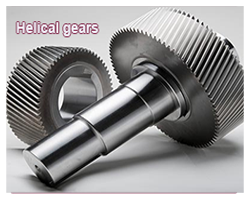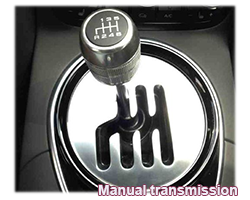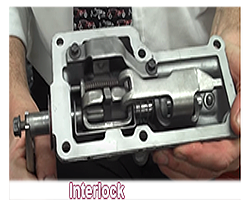
HEEL: Describes the wide end of a tapered gear tooth as found in the differential gears.
HELICAL DIFFERENTIAL: Describes the method found in all gears found in modern cars are cut that have a spiral helix angle rather than straight meshing.
HELICAL GEAR: Describes a gear that has the teeth cut at an angle to the centre line of the gear, meaning that the chance of intermittent tooth-to-tooth operation happening being very slime as there are at least two teeth engaged at any time.
HELICAL TEETH: Describes curved gear teeth that sit on the edge of a gearwheel, cut at an angle to its axis
HOTCHKISS DRIVE: Describes a method of connecting a transmission output shaft to the differential pinion by using open driveshafts combining both steering axis and camber angles.
IDLER GEAR: Describes the gear placed between two other gears to reverse the direction of rotation of the output gear.
IDLER: Describes a gearwheel situated between the driving and the driven gear in a gear train serving to reverse the original direction of rotation of the driven wheel.
INTERLOCK: Describes a device in a change-speed gearbox that prevents two gears from engaging simultaneously.
INTERMEDIATE GEAR: Describes any forward gear in the auto transmission between first and high.
LOCKING SYNCHROMESH: Describes a common synchromesh mechanism in which the gear and gearchange sleeve are prevented from engaging until rotational speeds are synchronised
MAIN SHAFT: Describes the principle transmission output shaft.
MANUAL TRANSMISSION: Describes a traditional transmission system in which gears are selected by the driver by means of a hand-operated gearshift and a foot-operated clutch.
MANUAL VALVE (MV): Describes a control system in automatic transmission that distributes line pressure to the various control valves and pistons which operate the clutches. The manual valve is driver operated through a selector lever.
MODULATOR: Describes an adjusting valve used in the hydraulic system of an automatic transmission whose role it is to increase the pressure to hold the clutches in place. When the vehicle is under full throttle, the modulator reduces pressure to provide smoother gear shifts.
NEUTRAL (N): Describes the neutral position of an automatic transmission where the engine is unable to drive the wheels. Neutral is placed between reverse and one of the forward gears in automatic transmissions.
NEUTRAL DRIVE SWITCH (NDS): Describes a sensor whose role it is to provide information on transmission status to the on-board computer.
NEUTRAL SAFETY SWITCH: Describes a switch which that the starter to be engaged only when the automatic shift lever is in either neutral or park.
OVERALL GEAR RATIO: Describes the ratio of engine revolutions to road wheel revolutions, generating road speed as a ratio of engine speed (mph per 1000 rpm)
OVERDRIVE: Describes an additional gearbox, mounted in the driveline, that can reduce gas consumption during sustained high-speed driving as well as engine noise and engine wear.
OVERDRIVE TRANSMISSION: Describes a form of transmission whose high gear acts as an overdrive.
OUTPUT SPEED: Describes the speed of the transmission output shaft transmitted to the driven wheels via the final drive.
PARK (P): Describes one of the key positions on the gear selector of an automatic gearbox that, when engaged, will lock the driving wheels.
REVERSE GEAR (R). Describes the gear that allows a car to be driven backwards.
REVERSE INHIBITOR VALVE: Describes the valve whose role it is to prevent the reverse being engaged in an automatic transmission if the vehicle road speed exceeds six miles per hour.
ROLL PIN: Describes a spring steel split pin with a tube-like appearance used attaching disc pads to shafts in gearboxes.
All Categories
- Home Page
- Mechanics
Mechanics
Back- Camshaft
- Carburettors A-C
- Carburettors D-F
- Carburettors H-M
- Carburettors R-W
- Clutch B-C
- Clutch D-W
- Cooling System A-C
- Cooling System D-F
- Cooling System H-W
- Crankshaft A-C
- Crankshaft D-W
- Cylinder Head
- Engine A-D
- Engine E
- Engine F-L
- Engine M-S
- Engine T-X
- Filters
- Fuel Control Systems A-E
- Fuel Control Systems F
- Fuel Control Systems M-S
- Gearbox A-D
- Gearbox E-G
- Gearbox H-R
- Gearbox S-W
- Oil Control Systems C-W
- Oil Control Systems
- Pistons
- Auto Electrics
- Brakes,Suspension and Steering
Brakes,Suspension and Steering
Back- Axles
- Brakes A-B
- Brakes E-D
- Brakes FL
- Brakes M-R
- Brakes S-Y
- Differential
- Drive Systems
- Exhaust Systems A-D
- Exhaust Systems E
- Exhaust Systems F-Y
- Hydraulics
- Shock Absorbers
- Springs
- Steering A-R
- Steering S-V
- Suspension A-H
- Suspension I-R
- Suspension S-W
- Tires A-F
- Tires G-B
- Tires S-W
- WheelsA-I
- WheelsI-S
- Wheels T-V
- Bodywork
- Exterior Trim
- Interior Trim
- Paintwork
- Parts and Fittings
- Tools and Equipment
Tools and Equipment
Back 



- Site Map
- Privacy Policy
- Contact Us


All you need to know on how to acquire, restore and maintain a Classic Car
Step back in time to the renaissance age of the UK and European Car Industries
> All that is happening NOW in the world of classic cars.
Step into the golden decade of the UK and European Car Industries
and catch up with all the latest news and features.
Sign up for a Classic Car Info Twitter account.
ae4









